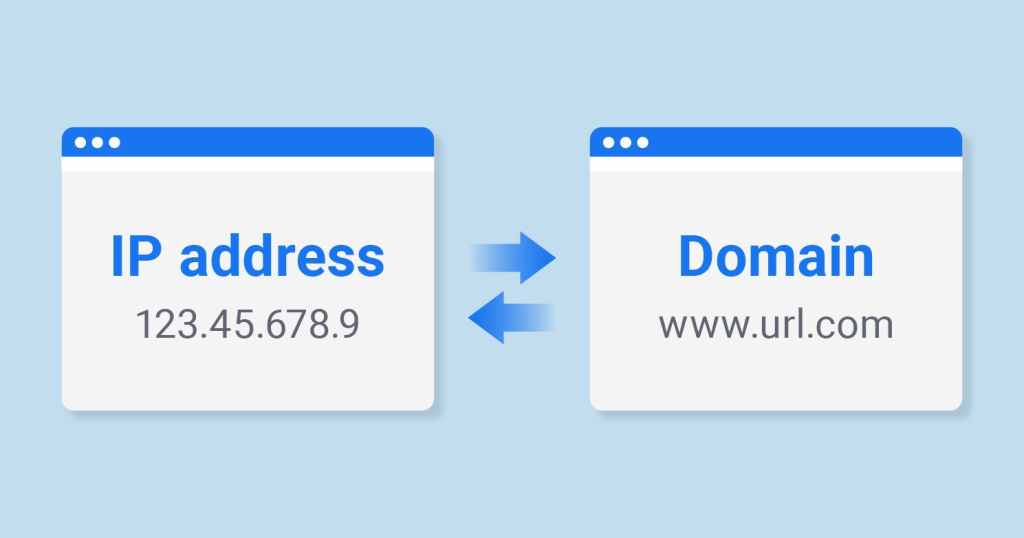What is a Domain Name and Difference between Domain Name and IP address
What is a Domain Name?

A domain name is a unique, human-readable address used to identify and access websites on the internet. It serves as a more accessible alternative to the numerical IP addresses that computers use to identify each other.
For example, in the domain name “example.com”:
- “example” is the second-level domain, which typically represents the name of the website or organization.
- “.com” is the top-level domain (TLD), indicating the domain’s category or geographical area.
When you type a domain name into a web browser, the domain name system (DNS) translates it into the corresponding IP address, allowing you to access the website hosted at that address.
Table of Contents
What are the different extension in domain

Domain extensions, also known as Top-Level Domains (TLDs), are the suffixes at the end of domain names. There are various types of domain extensions, each serving different purposes. Here’s an overview of the different types of TLDs:
1. Generic Top-Level Domains (gTLDs)
These are the most common and widely recognized domain extensions. They are not tied to any specific country or region.
- .com (Commercial) – The most popular and widely used TLD, typically for commercial businesses.
- .org (Organization) – Often used by non-profit organizations.
- .net (Network) – Originally intended for networking organizations but is now used more broadly.
- .info (Information) – Typically used for informational websites.
- .biz (Business) – Used for business or commercial purposes.
- .name (Personal) – Intended for personal sites or blogs.
- .gov (Government) – Reserved for U.S. government entities.
- .edu (Education) – Used by educational institutions, primarily in the U.S.
- .mil (Military) – Reserved for the U.S. military.
2. Country Code Top-Level Domains (ccTLDs)
These extensions are specific to individual countries or territories and are often used by websites based in those regions.
- .uk (United Kingdom)
- .ca (Canada)
- .de (Germany)
- .jp (Japan)
- .in (India)
- .au (Australia)
- .cn (China)
- .ru (Russia)
3. New Generic Top-Level Domains (nTLDs)
In recent years, new TLDs have been introduced to expand the available options for domain names. These are often more specialized or industry-specific.
- .app – Used by app developers and tech companies.
- .blog – Intended for bloggers.
- .shop – Designed for e-commerce websites.
- .tech – Suitable for technology-related websites.
- .xyz – A general-purpose TLD, often used for innovation and creativity.
- .online – Popular for online businesses and personal sites.
- .guru – Used by experts or consultants in various fields.
4. Sponsored Top-Level Domains (sTLDs)
These are specialized TLDs that are sponsored by specific communities or organizations.
- .aero – For the air transport industry.
- .coop – For cooperative organizations.
- .museum – For museums.
- .travel – For travel-related businesses and organizations.
- .jobs – For job-related websites.
What are the difference between Domain Name and IP address

A domain name and an IP address are both fundamental components of how the internet functions, but they serve different purposes and are used in different contexts. Here’s a breakdown of the key differences:
1. Function and Purpose
- Domain Name:
- A domain name is a human-readable identifier used to access a website or service on the internet. It’s designed to be easy to remember and use.
- Example:
www.example.com - Purpose: Makes it easier for people to navigate the web by providing a memorable address for websites.
- IP Address:
- An IP (Internet Protocol) address is a numerical label assigned to each device connected to a network that uses the Internet Protocol for communication. It’s how computers identify and communicate with each other.
- Example:
192.168.1.1(IPv4) or2001:0db8:85a3:0000:0000:8a2e:0370:7334(IPv6) - Purpose: Allows computers and devices to locate and communicate with each other over the internet.
2. Human-Readability
- Domain Name:
- Designed to be easily remembered and typed by humans.
- Example:
amazon.comis far easier to recall than a string of numbers.
- IP Address:
- Typically consists of a series of numbers (IPv4) or a combination of numbers and letters (IPv6), which are not intuitive or easy to remember for most people.
- Example:
192.0.2.1or2606:4700:4700::1111.
3. Structure
- Domain Name:
- Composed of multiple parts, including the top-level domain (TLD) and the second-level domain (SLD). For instance, in
www.example.com:exampleis the SLD..comis the TLD.
- Domain names can also include subdomains, like
blog.example.com.
- Composed of multiple parts, including the top-level domain (TLD) and the second-level domain (SLD). For instance, in
- IP Address:
- Comes in two formats:
- IPv4: A 32-bit number divided into four octets (e.g.,
192.168.1.1). - IPv6: A 128-bit number represented in eight groups of four hexadecimal digits (e.g.,
2001:0db8:85a3:0000:0000:8a2e:0370:7334).
- IPv4: A 32-bit number divided into four octets (e.g.,
- Comes in two formats:
4. Translation
- Domain Name:
- Requires a translation process (via DNS) to map to an IP address. When you type a domain name into a browser, the DNS system translates it into the corresponding IP address so that your device can locate the correct server.
- IP Address:
- No translation is needed for communication between devices; it directly identifies a specific device or server on the network.
5. Flexibility
- Domain Name:
- Can be easily changed or redirected to point to different IP addresses. This makes it possible to change the server hosting your website without changing the domain name.
- IP Address:
- Typically assigned to a device or server and may change (especially in dynamic IP settings). It’s less flexible and more technical to manage.
6. Memorability
- Domain Name:
- Designed for easy recall and branding, making it ideal for public-facing websites and services.
- IP Address:
- Primarily for use in networking and backend systems where memorability is less of a concern.
Summary
- Domain Name: A user-friendly name that represents a website or service, making it easy for people to find and access online resources.
- IP Address: A numerical label that identifies a specific device or server on the internet, enabling computers to communicate with each other.
In essence, domain names provide a convenient way for users to access websites, while IP addresses handle the underlying technical communication between devices on the internet.
